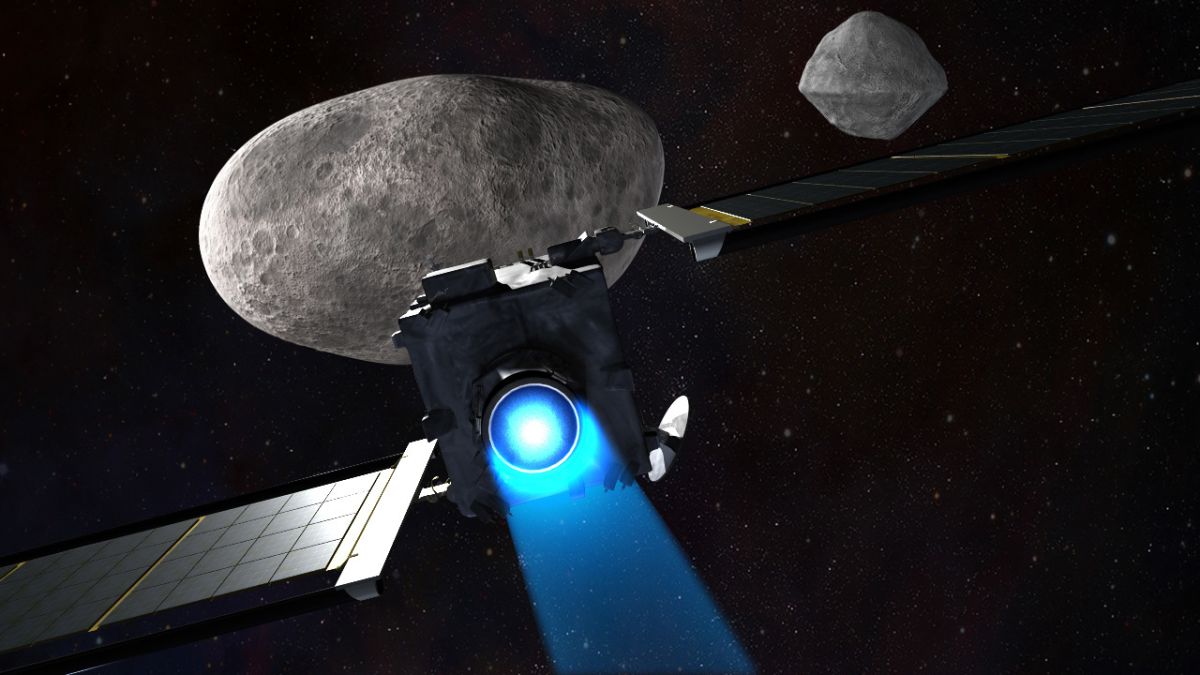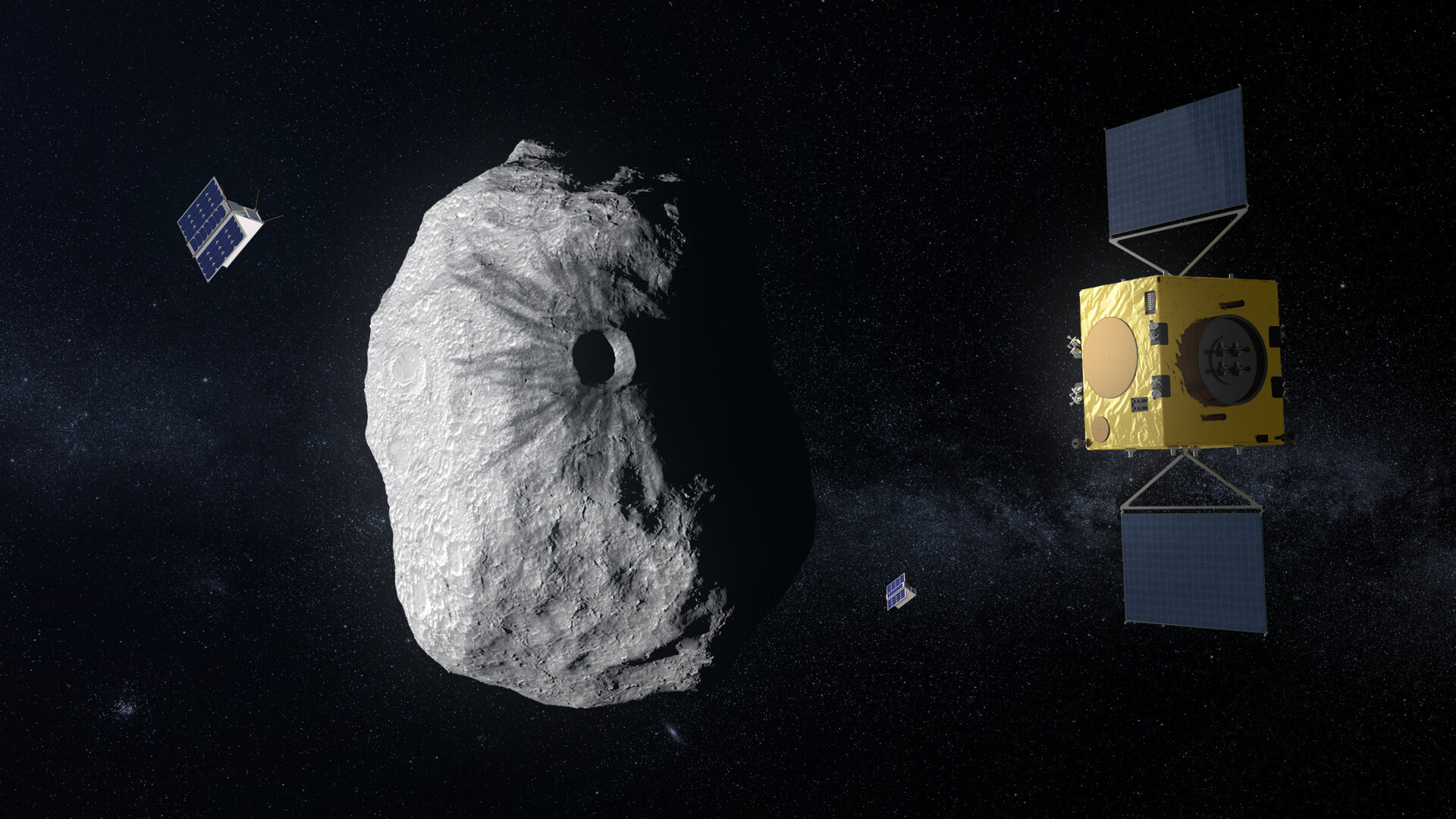The US Double Asteroid Redirection Test (DART), the world’s first mission to test technology for defending Earth against potential asteroid or comet hazards, will impact its target asteroid Dimorphos on September 26, NASA and Johns Hopkins Applied Physics Laboratory (APL) mission planners told a press conference on Monday.
Armed With Laser Weapons & Hypersonic Missiles, US Navy To Develop Next-Gen Warship To Replace Aging Destroyers
“While DART’s target asteroid is not a threat to our planet, this test will see if asteroid deflection using a kinetic impactor spacecraft is a viable way to respond to a future asteroid on a collision course with earth should one ever be discovered,” NASA Science Mission Directorate Associate Administrator Thomas Zurbuchen said.
Dart is a first-of-its-kind spacecraft that will automatically navigate to a target asteroid and intentionally collide with it to change the asteroid’s motion in a way that can be measured using ground-based telescopes, Zurbuchen said.
“For the first time, we will measurably change the orbit of a celestial body in the universe. Doing so has clear benefits in ensuring humanity’s ability to deflect any potential threatening asteroid in the future,” APL Director Bobby Brown told reporters.
DART will provide important data to help better prepare for an asteroid that might pose an impact hazard to Earth, should one ever be discovered, NASA said in a statement.
Asteroid Dimorphos is part of a binary asteroid system with Didymos, which consists of a small moon (Dimorphos) orbiting the larger body (Didymos). Because the two asteroids do not threaten Earth, they were chosen as the target for NASA’s DART mission.
New Findings
“Contrary to what one might imagine when picturing an asteroid, direct evidence from space missions like the Japanese space agency’s (JAXA) Hayabusa2 probe demonstrates that an asteroid can have a very loose internal structure – similar to a pile of rubble – that is held together by gravitational interactions and small cohesive forces”, says study lead-author Sabina Raducan from the Institute of Physics and the National Centre of Competence in Research PlanetS at the University of Bern.
“This could drastically change the outcome of the collision of DART and Dimorphos, which is scheduled to take place in the coming September,” Raducan points out.
Chaitanya Giri, a Space Tech Consultant with Research and Information System for Developing Countries (RIS), explained to EurAsian Times that the Dimorphos-Didymos binary asteroids have been studied for a long time, and Didymos, the bigger of the two, has “surface reflective properties that indicate it to be a stony (S-type) asteroid.”
“Now, S-type asteroids too can be rubble piles. JAXA’s Hayabusa-2 visited an S-type rubble-pile asteroid, Itokawa. It was a peanut-like structure with varying densities,” Giri said.
However, Giri pointed out that, unlike Didymos, Itokawa was not coupled with another asteroid. He further noted that not all rubble piles are alike, as rubble may have different mineralogy.
“Some (rubble piles) may have more boulders and less dust, some may have more dust and few boulders, some may even have traces of iron-nickel, carbonaceous content, and ices,” he said.
Another essential thing that Giri highlighted is that in the case of binary asteroids, it has often been inferred that they do not differ much in their composition, and based on that, it is likely that Dimorphos – on which the DART mission will make an impact – may not be entirely dissimilar to Didymos.
“The DART principal investigating team thinks the same too,” said Giri.
Therefore, it is likely that Didymos could be made of stone materials. However, “nothing conclusive can be known unless a spacecraft gets up close and gets some remote sensing done,” Giri added.
DART Could Completely Deform The Asteroid
Based on the inference that Dimorphos’s internal structure is a rubble pile, Sabina Raducan’s simulation shows that DART spacecraft with a speed of around 24,000 kph could completely deform the asteroid and that the target could be deflected much more strongly.
Also, a larger amount of material could be ejected from the impact than the previous studies had estimated.

When asked about the potential risks emanating from the material ejecting out of the asteroid following the impact, Giri told Eurasian Times that he does not think there is anything to worry about while noting all the necessary precautions be taken.
He said that Dimorphos is extremely small, roughly 165 meters wide, and therefore the DART probe impact on it will not unleash large volumes of material.
“Even if it turns out to be a rubble pile, the impact will only eject small stones, dust, volatiles,” Giri said.
Raducan and her team were awarded by European Space Agency (ESA) and by the mayor of Nice at a workshop on the DART follow-up mission HERA for having simulated the entire process of crater formation in the aftermath of impact on small asteroids like Dimorphos.
“One of the reasons that this scenario of a loose internal structure has so far not been thoroughly studied is that the necessary methods were not available,” Raducan said.
Such impact conditions cannot be recreated in laboratory experiments, and the relatively complex crater formation process after such an impact – a matter of hours in the case of DART – made it impossible to simulate these impact processes until now, according to the researcher.
The ESA will send the HERA mission to Dimorphos in 2024 to investigate the aftermath of the DART spacecraft’s impact.

“To get the most out of the HERA mission, we need to have a good understanding of potential outcomes of the DART impact,” said the study co-author with Raducan, Martin Jutzi from the Institute of Physics the National Centre of Competence in Research PlanetS.
He said their simulation of the DART probe impact had added a crucial potential scenario that has widened the expectations in this regard.
“This is not only relevant in the context of planetary defense but also adds an important piece to the puzzle of our understanding of asteroids in general,” Jutzi said.
DART Mission
DART is the first mission of its kind to investigate and demonstrate planetary defense using the asteroid deflection method by changing the asteroid’s motion in space through kinetic impact.
When asked about the future of the DART mission following its scheduled impact on Dimorphos in September, Chaitanya Giri said that the mission would not end, despite meeting its target in September, and the teams overseeing this mission will continue to monitor the trajectory of Dimorphos for years to come.
“It is not a shoot-and-forget mission,” said Giri.
Furthermore, he said that studies would also be done about changes to Didymos’ density, its trajectory, the difference in the asteroid’s volume, the chemical characterization of the ejected asteroidal material, and its orbital eccentricity.
Giri noted that Didymos will come closer to Earth in 2042 and 2062. The DART scientists or the next generation of scientists they nurture will monitor the differences in Dimorphos before and after it. He also indicated the next iteration of the DART mission.
“There might be another DART mission, a DART-II either around 2042 or 2062, which would further deflect this potentially hazardous asteroid (PHA) from hitting the Earth. This long-range preparation shows asteroid deflection is not a knee-jerk initiative; it has to be studied well.”
- Contact the author at tanmaykadam700@gmail.com
- Original Analysis Here
- Follow EurAsian Times on Google News




